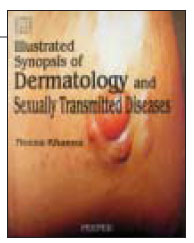
|
Indian Journal of Dermatology, Venereology and Leprology
Medknow Publications on behalf of The Indian Association of Dermatologists, Venereologists and Leprologists (IADVL)
ISSN: 0378-6323 EISSN: 0973-3922
Vol. 72, Num. 2, 2006, pp. 182-182
|
Indian Journal of Dermatology, Venereology and Leprology, Vol. 72, No. 2, March-April, 2006, pp. 182
Book Review
Illustrated synopsis of dermatology and sexually transmitted diseases
Kumar Bhushan
Code Number: dv06063
Neena Khanna
2005, Peepee Publishers and Distributors (P) Ltd, New Delhi, India.
Pages: 335, Price: Rs. 345.00

I had the privilege of reviewing Illustrated Synopsis of Dermatology and Sexually Transmitted Diseases, written
by Prof. Neena Khanna. It is indeed a great effort because it involves
condensing many volumes in 335 pages. Selecting the relevant is the most
difficult task and the author has commendably done this. For further
impact, synopses have been added. I wish a few more pages had been written
about leprosy, a disease still relevant to us and then the title would
have been complete with ′Leprology′ added to it.
Though it is easy to read, the book has some deficiencies/errors that
are at places, only typographical but at places, more serious. This would
need
the attention of the author if another edition is planned. Some of the
more important errors are elaborated below. Though the description is correct
in the text, the apocrine duct in Fig. 7.19 is wrongly shown opening into
the hair follicle below the opening of sebaceous duct. The causative organism
of genital chlamydial infection has been mentioned as serovars A, B or
C instead of the actual serovars D-K (p. 244). The table giving the differentiating
features between lichen planus and lichenoid eruption needs corrections
(p. 47). Contraception after oral retinoids should preferably be one year
and not one month as mentioned on page 91. Similarly, the sentence ′In telogen effluvium, follicles enter the phase of catagen (resting phase)′ needs correction (p. 104).
The WHO recommendations (1997) did not mention nerve involvement for
deciding the treatment for PB or MB leprosy (p. 206). The doses of various
medications
at many places need to be corrected (famciclovir, p. 215; acyclovir for
suppressive therapy, p. 242; dithranol concentration, p. 311; fluconazole
for dermatophytic infections and pityriasis versicolor, p. 315) and at
places, to be mentioned (dose of famciclovir for herpes zoster, p. 316).
There is also a discrepancy in the duration of treatment for chlamydial
infection in the synopsis (seven days, p. 244) and in the text (2 weeks,
p. 245). The concentrations of topical corticosteroids (p. 308), podophyllin
and podophyllotoxin (p. 309) need attention. Conceptually, the suggestion
to begin with the least potent topical corticosteroid and then graduate
to a more potent one is incorrect (p. 308). Also, for candidal genital
infections, treatment of sexual partners is not uniformly recommended (p.
247). Lasers are not the best nor are they the only treatment for lymphangioma
(p. 286) and rather than minocycline, tetracyclines are the drug of choice
for chlamydial infections (p. 312). The probable errors in printing - for
instance, ′>19% body weight loss′ quoted in Table 15.11 (p. 253) in the Expanded WHO Case Definition for AIDS Surveillance and the number of copies of HIV RNA that implies undetectable levels printed as ′< 500′ (p. 257) - call for more vigilant proofreading during the next revision of this book.
This book is a good read for undergraduates and even postgraduates,
at the beginning of their career and for a very quick revision.
Copyright 2006 - Indian Journal of Dermatology, Venereology and Leprology
|
